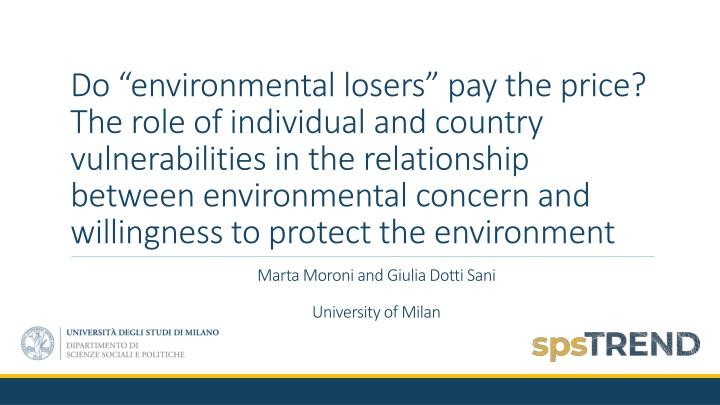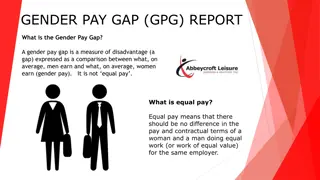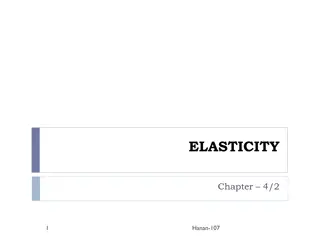Do Environmental Losers Pay the Price? Individual and Country Vulnerabilities in Environmental Concern
The study explores the relationship between environmental concern and willingness to protect the environment, considering individual and country vulnerabilities. It analyzes climate and economic vulnerabilities across countries and the impact of climate risks, extreme weather experiences, low GDP countries, and low-income individuals on environmental protection willingness.
Download Presentation

Please find below an Image/Link to download the presentation.
The content on the website is provided AS IS for your information and personal use only. It may not be sold, licensed, or shared on other websites without obtaining consent from the author.If you encounter any issues during the download, it is possible that the publisher has removed the file from their server.
You are allowed to download the files provided on this website for personal or commercial use, subject to the condition that they are used lawfully. All files are the property of their respective owners.
The content on the website is provided AS IS for your information and personal use only. It may not be sold, licensed, or shared on other websites without obtaining consent from the author.
E N D
Presentation Transcript
Do environmental losers pay the price? The role of individual and country vulnerabilities in the relationship between environmental concern and willingness to protect the environment Marta Moroni and Giulia Dotti Sani University of Milan
Introduction The pace and scale of climate action are insufficient to tackle climate change (IPCC, Sixth Assessment Report 2023) (Poortinga et al. 2019; Baiardi , 2022) High concern for the environment, high awareness for the issue of climate change BUT Low willingness to accept costs to protect the environment and mitigate climate change (Fairbrother 2022) Introduction Background Data and Methods Results Conclusions
Research Objectives Climate and Economic Vulnerabilities Cross-country comparison Willingness to accept costs to protect the environment Environmental Concern Introduction Background Data and Methods Results Conclusions
Background Willingness to accept costs to protect the environment Environmental Concern Theory of Planned Behavior Positive but modest effect of environmental concern Differences according to the specificness of the measure of policy support or willingness to sacrifice Differences across countries (Hornsey et al., 2016; Mayerl and Best, 2019; Dienes, 2015) Introduction Background Data and Methods Results Conclusions
Background CLIMATE VULNERABILITIES ECONOMIC VULNERABILITIES Perceived Experience of extreme weather events Country Climate Risk Low Household Income Country GDP (Ogunbode et al., 2019; Tvinnereim et al., 2020) (McConnel, 1997; Franzen and Mayer, 2010; Dienes, 2015;Low and Chow 2013; Franzen, 2003) Vulnerabilities Willingness to accept costs to protect the environment Environmental Concern Introduction Background Data and Methods Results Conclusions
Hypotheses WILLINGNESS to protect the environment WILLINGNESS to protect the environment High Climate risk Countries Extreme weather experience Low GDP countries Low-income individuals CONCERN CONCERN Country level Individual level Introduction Background Data and Methods Results Conclusions
Data and Methods Multilevel Regression Models ISSP 2020 - Environment IV N: 36 936 27 countries worldwide: Austria, Australia, Denmark, Finland, France, Germany, Hungary, Norway, Iceland, Italy, Spain, Switzerland US, Japan, New Zealand, Lithuania, Slovakia, Croatia, Hungary, India, South Korea, Philippines, Russia, Slovenia, South Africa, Thailand, China Introduction Background Data and Methods Results Conclusions
Dependent variable Response Options: How willing would you be -Very unwilling To pay much higher prices -Fairly unwilling To pay much higher taxes -Neither unwilling nor willing in order to protect the environment? -Fairly willing -Very willing Average of the two items in a 1-5 scale (from very unwilling to very willing) Willingness to accept costs to protect the environment (Cronbach s Alpha: 0.83) Introduction Background Data and Methods Results Conclusions
Independent variables The extent to which the neighborhood was affected by an Country s Climate Risk Assessment: World Risk Index: extreme weather events (such as severe storms, droughts, exposure + vulnerability. 0 (low risk) to floods, heat waves, cold snaps, etc.) over the last twelve months: 100 (high risk) Not at all; To a small extent; To some extent; To a great extent GDP per capita, PPP Income: quintiles Controls: age, gender, education Introduction Background Data and Methods Results Conclusions
Willingness to pay to protect the environment Introduction Background Data and Methods Results Conclusions
Austria Denmark Finland Germany Iceland New Zealand Slovenia Results Environmental Concern on Willingness to Pay Switzerland Australia France Korea Norway Spain Sweden Country by Country US Japan China Croatia Lithuania Slovakia India Italy Russia Hungary South Africa Philippines Thailand Note: Predicted mean values at 95% confidence intervals. Predictions control for countries, gender, education, income Introduction Background Data and Methods Results Conclusions
Results Moderator effects of Individual vulnerabilities Note: Fixed effects of Multilevel models. Models include gender, education, age. Introduction Background Data and Methods Results Conclusions
Results Moderator effects of Country Climate Risk Note: Fixed effects of Multilevel random slope models. Models include sex, education, age, household income. Introduction Background Data and Methods Results Conclusions
Results Moderator effects of GDP Note: Fixed effects of Multilevel random slope models. Models include sex, education, age, household income. Introduction Background Data and Methods Results Conclusions
Conclusion Environmental concern positively influences the willingness to accept costs to protect it. BUT differences across countries. Differences in the relationship between environmental concern and willingness to pay seem to be explained in a higher extent by economic vulnerabilities than by climate vulnerabilities. Introduction Background Data and Methods Results Conclusions
Thank you! marta.moroni@unimi.it























